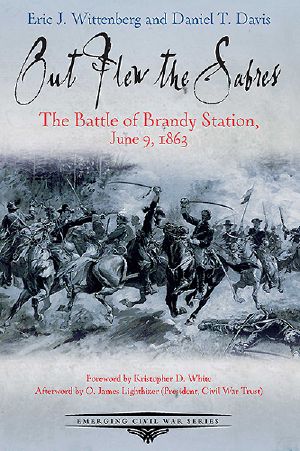Out Flew the Sabres

- Authors
- Wittenberg, Eric J.
- Publisher
- Savas Beatie
- Tags
- history , united states , civil war period (1850-1877)
- ISBN
- 9781611212563
- Date
- 2015-10-19T00:00:00+00:00
- Size
- 8.07 MB
- Lang
- en
One day. Fourteen hours. Twelve thousand Union cavalrymen against 9,000 of their Confederate counterpartswith three thousand Union infantry thrown in for good measure. Amidst the thunder of hooves and the clashing of sabers, they slugged it out across the hills and dales of Culpepper County, Virginia.And it escalated into the largest cavalry battle ever fought on the North American continent.Fleetwood Hill at Brandy Station was the site of four major cavalry battles during the course of the Civil War, but none was more important than the one fought on June 9, 1863. That clash turned out to be the opening engagement of the Gettysburg Campaignand the one-day delay it engendered may very well have impacted the outcome of the entire campaign.The tale includes a veritable whos-who of cavalry all-stars in the East: Jeb Stuart, Wade Hampton, John Buford, and George Armstrong Custer. Robert E. Lee, the great Confederate commander, saw his son, William H....
And it escalated into the largest cavalry battle ever fought on the North American continent.
Fleetwood Hill at Brandy Station was the site of four major cavalry battles during the course of the Civil War, but none was more important than the one fought on June 9, 1863. That clash turned out to be the opening engagement of the Gettysburg Campaign—and the one-day delay it engendered may very well have impacted the outcome of the entire campaign.
The tale includes a veritable who’s-who of cavalry all-stars in the East: Jeb Stuart, Wade Hampton, John Buford, and George Armstrong Custer. Robert E. Lee, the great Confederate commander, saw his son, William H. F. Lee, being carried off the battlefield, severely wounded. Both sides suffered heavy losses.
But for the Federal cavalry, the battle was also a watershed event. After Brandy Station, never again would they hear the mocking cry, “Whoever saw a dead cavalryman?”
One day. Fourteen hours. Twelve thousand Union cavalrymen against 9,000 of their Confederate counterparts with three thousand Union infantry thrown in for good measure. Amidst the thunder of hooves and the clashing of sabers, they slugged it out across the hills and dales of Culpepper County, Virginia.And it escalated into the largest cavalry battle ever fought on the North American continent.Fleetwood Hill at Brandy Station was the site of four major cavalry battles during the course of the Civil War, but none was more important than the one fought on June 9, 1863. That clash turned out to be the opening engagement of the Gettysburg Campaign and the one-day delay it engendered may very well have impacted the outcome of the entire campaign.The tale includes a veritable who s-who of cavalry all-stars in the East: Jeb Stuart, Wade Hampton, John Buford, and George Armstrong Custer. Robert E. Lee, the great Confederate commander, saw his son, William H. F. Lee, being carried off the battlefield, severely wounded. Both sides suffered heavy losses.But for the Federal cavalry, the battle was also a watershed event. After Brandy Station, never again would they hear the mocking cry, Whoever saw a dead cavalryman? In Out Flew the Sabers: The Battle of Brandy Station, June 9, 1863 The Opening Engagement of the Gettysburg Campaign, Civil War historians Eric J. Wittenberg and Daniel T. Davis have written the latest entry in Savas Beatie s critically acclaimed Emerging Civil War Series."